The 2020 Mac Mini Unleashed: Putting Apple Silicon M1 To The Test
by Andrei Frumusanu on November 17, 2020 9:00 AM ESTBenchmarks: Whatever Is Available
As we’ve had very little time with the Mac mini, and the fact that this not only is a macOS system, but a new Arm64-based macOS system, our usual benchmark choices that we tend to use aren’t really available to us. We’ve made due with a assortment of available tests at the time of the launch to give us a rough idea of the performance:

One particular benchmark that sees the first light of day on macOS as well as Apple Silicon is Cinebench. In this first-time view of the popular Cinema4D based benchmark, we see the Apple M1 toe-to-toe with the best-performing x86 CPUs on the market, vastly outperforming past Apple iterations of Intel silicon. The M1 here loses out to Zen3 and Tiger Lake CPUs, which still seem to have an advantage, although we’re not sure of the microarchitectural characteristics of the new benchmark.
What’s notable is the performance of the Rosetta2 run of the benchmark when in x86 mode, which is not only able to keep up with past Mac iterations but still also beat them.
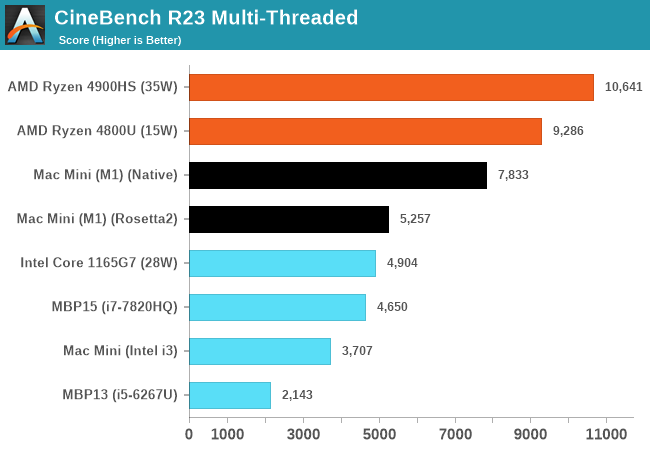
In the multi-threaded R23 runs, the M1 absolutely dominates past Macs with similar low-power CPUs. Just as of note, we’re trying to gather more data on other systems as we have access to them, and expand the graph in further updates of the article past publishing.
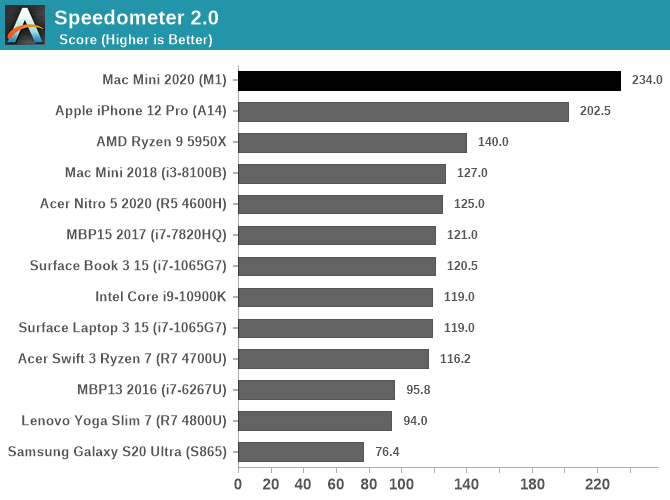
In browser-benchmarks we’ve known Apple’s CPUs to very much dominate across the landscape, but there were doubts as to whether this was due to the CPUs themselves in the iPhone or rather just the browsers and browser engines. Now running on macOS and desktop Safari, being able to compare data to other Intel Mac systems, we can come to the conclusion that the performance advantage is due to Apple’s CPU designs.
Web-browsing performance seems to be an extremely high priority for Apple’s CPU, and this makes sense as it’s the killer workload for mobile SoCs and the workload that one uses the most in everyday life.
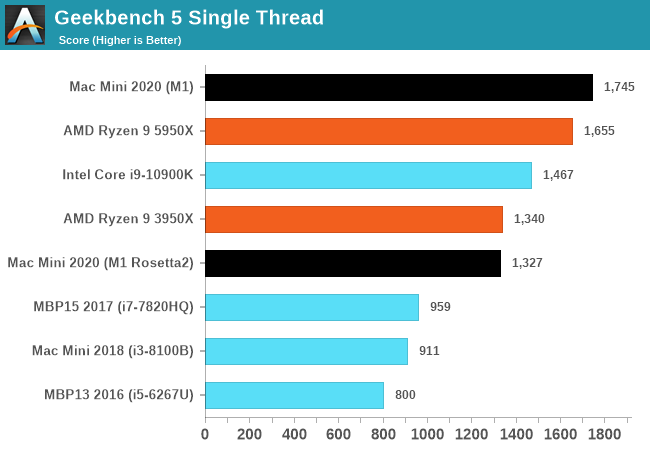
In Geekbench 5, the M1 does again extremely well as it actually takes the lead in our performance figures. Even when running in x86 compatibility mode, the M1 is able to match the top single-threaded performance of last generation’s high-end CPUs, and vastly exceed that of past iterations of the Mac mini and past Macbooks.
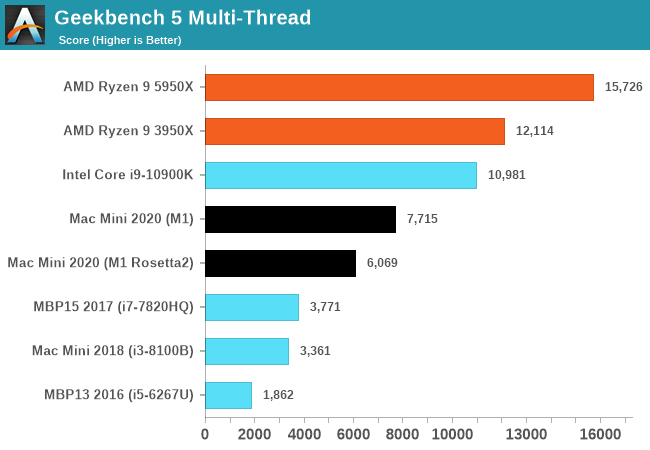
Multi-threaded performance is a matter of core-count and power efficiency of a design. The M1 here demolishes a 2017 15-inch Macbook Pro with an Intel i7-7820HQ with 4 cores and 8 threads, posting over double the score. We’ll be adding more data-points as we collect them.


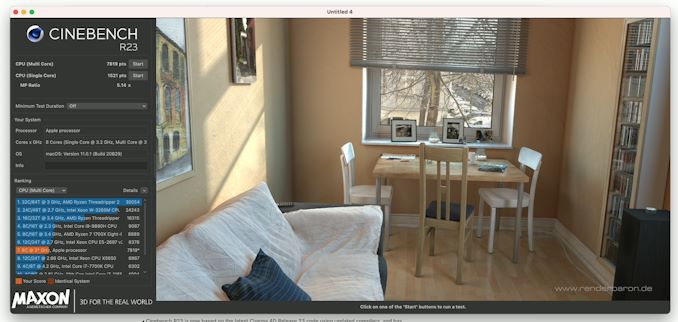








682 Comments
View All Comments
RedGreenBlue - Tuesday, November 17, 2020 - link
Obviously their new designs are way off the beaten path in their improvements than the canned designs by now.dotjaz - Wednesday, November 18, 2020 - link
You must be smoking something really good. A7 was a 6-wide design while CA57 was only 3-wide. Cyclone also has 4/2/2/3 (Int/Branch/LS/NEON) units while A57 only had (2+1)/1/2/2. That's completerly different design.RedGreenBlue - Wednesday, November 18, 2020 - link
I was thinking of the A6 that was the first modification of ARM’s architecture and before that they were fundamentally copies. It’s not easy to remember which article of Anand Shimpi’s commentary I read 7 or 8 years ago. https://www.anandtech.com/show/6330/the-iphone-5-r...danbob999 - Thursday, November 19, 2020 - link
They are dumb if they pay for designs which they do not use. The instruction set must be cheaper, otherwise ARM got it the wrong way.It's like saying that the cost of food at a groceries store is higher than the complete meal at the restaurant.
michael2k - Thursday, November 19, 2020 - link
It's actually more accurate to say, "Paying for the time of the restaurant's menu designer costs more than either the groceries or the meal"With an architectural license, they get access to to a specification, which is closer to a menu, recipes, and a shopping list, than a meal or groceries.
dotjaz - Wednesday, November 18, 2020 - link
No helios24 is INCORRECT. It's the top of the licensing for sure, but it also doesn't include any hard IP. It's the broadest in use case as you can do ANYTHING with it as long as you are ISA compliant. But it's also the narrowest in terms of ARM IP portfolio. For example Huwwei still hold ARM architectural license and can design their own ARM cores, but they don't have access to anything newer than CA77 because that's a different license.Architectual license is also the cheapest *once you have certain volume*. The initial licensing fee is high, BUT you don't pay much royalty on a per-core basis becase you don't use ARM IP other than ISA.
dotjaz - Wednesday, November 18, 2020 - link
Maybe this will help you understand more. The top of the pyrimid actually don't have access to ARM's standard IP portfolio at all.https://semiaccurate.com/2013/08/07/a-long-look-at...
michael2k - Thursday, November 19, 2020 - link
The article here contradicts you: https://semiaccurate.com/2013/08/07/a-long-look-at...On top of the pyramid is both the highest cost and lowest licensee count option, but those two factors are probably not directly related. The reason is this one is called an architectural license and you don’t actually get a core, you get a set of specs for a core and a compatibility test suite.
mjkpolo - Thursday, November 19, 2020 - link
Actaully nVidia purchased ARM lolHenry 3 Dogg - Friday, November 27, 2020 - link
"ARM was founded as a joint venture between Apple and Acorn."No. ARM was founded by Acorn spinning out its inhouse developed ARM chip as a separate company. Apple bought in later as an investment, and to prevent take overs that might threaten its Newton product.